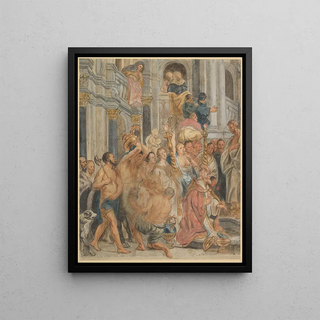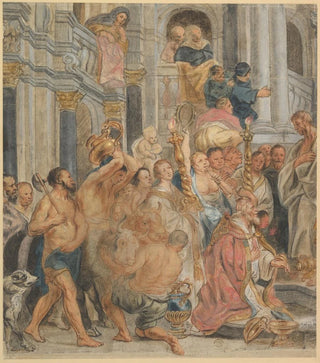Art print | Saint Paul at Lystra - Jacob Jordaens


View from behind

Frame (optional)
In the vast panorama of art history, certain works stand out for their ability to capture moments of profound emotional and spiritual impact. "Saint Paul at Lystra" by Jacob Jordaens is a striking example. This canvas, which immerses the viewer in a vibrant biblical scene, evokes the power of the Christian message through the gestures and expressions of the characters. Jordaens, master of Flemish baroque, manages to infuse a striking dynamism into his work, transforming a scriptural narration into an immersive visual experience. The art print Saint Paul at Lystra - Jacob Jordaens allows for appreciation of the richness of this composition, where every detail contributes to the intensity of the depicted scene.
Style and uniqueness of the work
Jordaens' work is characterized by a rich palette and bold use of light, which bring to life characters with striking expressions. In "Saint Paul at Lystra," the composition is carefully orchestrated, each figure positioned to create a fluid and captivating movement. The colorful drapery of the clothing, the faces marked by emotion, as well as the eloquent gestures of the characters, demonstrate exceptional technical mastery. The artist also uses strong contrasts to highlight the dramatic tensions of the scene, making palpable the impact of Saint Paul’s message. This work does not merely depict a biblical event; it invites reflection on faith, perseverance, and redemption.
The artist and his influence
Jacob Jordaens, born in 1593 in Antwerp, is one of the greatest representatives of Flemish baroque, alongside masters such as Rubens and Van Dyck. His work is distinguished by a humanist approach, emphasizing emotions and human interactions. Jordaens successfully integrated elements of daily life into his religious compositions, making his subjects accessible and close to the public. His influence extends beyond his era, inspiring many artists to explore similar themes and adopt a narrative style rich in detail. The way he manages to fuse the sacred and the profane in his works marked a turning point in religious art, opening

Matte finish

View from behind

Frame (optional)
In the vast panorama of art history, certain works stand out for their ability to capture moments of profound emotional and spiritual impact. "Saint Paul at Lystra" by Jacob Jordaens is a striking example. This canvas, which immerses the viewer in a vibrant biblical scene, evokes the power of the Christian message through the gestures and expressions of the characters. Jordaens, master of Flemish baroque, manages to infuse a striking dynamism into his work, transforming a scriptural narration into an immersive visual experience. The art print Saint Paul at Lystra - Jacob Jordaens allows for appreciation of the richness of this composition, where every detail contributes to the intensity of the depicted scene.
Style and uniqueness of the work
Jordaens' work is characterized by a rich palette and bold use of light, which bring to life characters with striking expressions. In "Saint Paul at Lystra," the composition is carefully orchestrated, each figure positioned to create a fluid and captivating movement. The colorful drapery of the clothing, the faces marked by emotion, as well as the eloquent gestures of the characters, demonstrate exceptional technical mastery. The artist also uses strong contrasts to highlight the dramatic tensions of the scene, making palpable the impact of Saint Paul’s message. This work does not merely depict a biblical event; it invites reflection on faith, perseverance, and redemption.
The artist and his influence
Jacob Jordaens, born in 1593 in Antwerp, is one of the greatest representatives of Flemish baroque, alongside masters such as Rubens and Van Dyck. His work is distinguished by a humanist approach, emphasizing emotions and human interactions. Jordaens successfully integrated elements of daily life into his religious compositions, making his subjects accessible and close to the public. His influence extends beyond his era, inspiring many artists to explore similar themes and adopt a narrative style rich in detail. The way he manages to fuse the sacred and the profane in his works marked a turning point in religious art, opening






